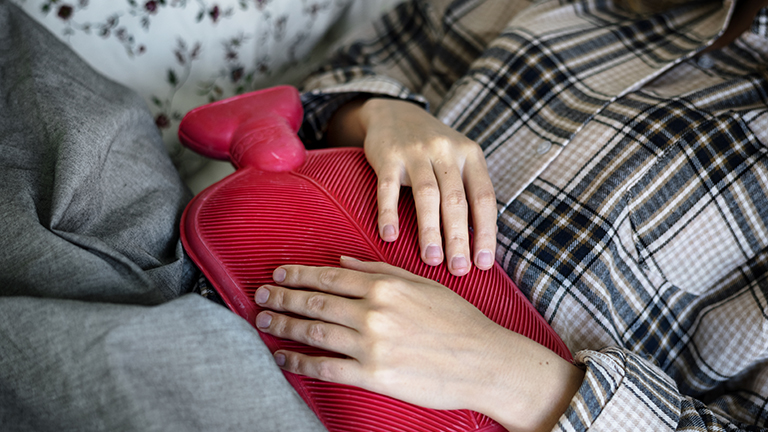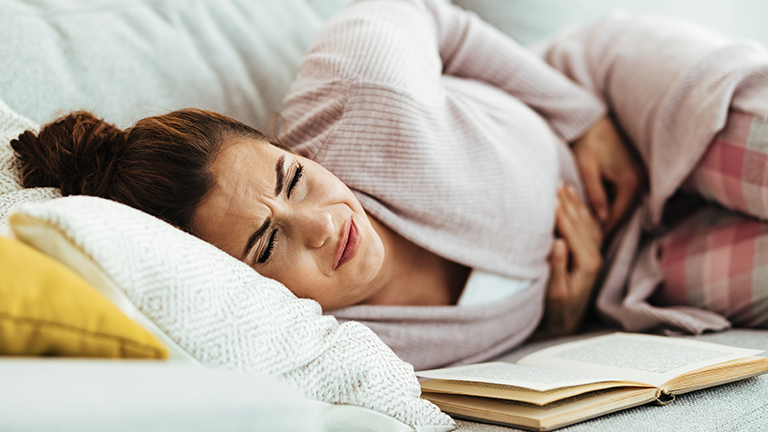Menstrual Pain Relief: Menstrual pain, also known as period cramps or dysmenorrhea, affects millions of women worldwide and is one of the most common menstrual health concerns. For some, cramps cause mild discomfort, while others experience severe pain that interferes with daily activities, work, and quality of life. The pain usually starts before or during menstruation and may last for one to three days, often radiating to the back and thighs.
The causes of menstrual pain vary. In primary dysmenorrhea, the discomfort is linked to prostaglandins—natural chemicals that cause the uterus to contract. In secondary dysmenorrhea, the pain is often associated with conditions like endometriosis, fibroids, or pelvic inflammatory disease.
Thankfully, there are many effective solutions for menstrual pain relief, ranging from natural remedies and lifestyle changes to medications and medical treatments. Understanding your options is the first step toward managing period pain and improving overall well-being.
What Is Menstrual Pain (Dysmenorrhea)?
Primary vs. Secondary Dysmenorrhea
- Primary dysmenorrhea refers to menstrual pain that is not caused by any underlying condition. It usually begins within a year or two after menstruation starts and is linked to the release of prostaglandins, which trigger uterine contractions.
- Secondary dysmenorrhea, on the other hand, is caused by conditions such as endometriosis, uterine fibroids, pelvic inflammatory disease, or adenomyosis. This type of pain tends to worsen with age and often requires medical evaluation.
Common Causes of Period Pain
- Overproduction of prostaglandins
- Hormonal imbalances (estrogen and progesterone fluctuations)
- Uterine contractions reducing blood flow
- Gynecological conditions (PCOS, endometriosis, fibroids)
- Stress and lifestyle factors
Symptoms of Menstrual Pain
Menstrual pain varies in intensity and symptoms. Common signs include:
- Cramping in the lower abdomen
- Pain radiating to the lower back or thighs
- Headaches and nausea
- Fatigue and weakness
- Digestive issues (bloating, diarrhea, constipation)
- Mood swings and irritability
Medical Approaches to Menstrual Pain Relief
Over-the-Counter Painkillers
Nonsteroidal anti-inflammatory drugs (NSAIDs) such as ibuprofen, naproxen, or aspirin are often the first line of treatment for period pain. These medications work by reducing prostaglandin production, thus lowering pain and inflammation.
- Ibuprofen (Advil, Motrin): Effective for moderate cramps.
- Naproxen (Aleve): Longer-lasting relief.
- Aspirin: Mild relief but not recommended for younger women due to potential side effects.
Prescription Medications
If over-the-counter painkillers are not effective, doctors may prescribe:
- Stronger NSAIDs
- Oral contraceptives (birth control pills) to regulate hormones and reduce painful periods
- Hormonal IUDs that release progestin, reducing uterine lining growth and cramps
Hormonal Birth Control Options
- Pills, patches, injections, and implants can help regulate menstrual cycles.
- They reduce ovulation, lower prostaglandin levels, and lighten periods.
- Beneficial for women with secondary dysmenorrhea caused by endometriosis or fibroids.
Natural Remedies for Menstrual Pain Relief
Heat Therapy (Heating Pads, Warm Baths)
Applying heat to the lower abdomen relaxes uterine muscles and increases blood flow, providing quick pain relief. Heat therapy is one of the simplest and most effective home remedies for period pain.
[INSERT_ELEMENTOR id=”5108″]
Herbal Remedies and Teas
Certain herbs have been used for centuries to ease cramps:
- Ginger tea – anti-inflammatory properties reduce prostaglandins.
- Chamomile tea – natural muscle relaxant and stress reliever.
- Cinnamon tea – improves blood circulation and reduces clotting.
Essential Oils and Aromatherapy
Massaging the abdomen with diluted lavender, clary sage, or peppermint oil can reduce muscle tension and provide a calming effect. Aromatherapy also helps relieve stress, which may worsen cramps.
Lifestyle and Home Remedies
Best Diet and Hydration for Menstrual Health
- Increase omega-3 fatty acids (salmon, flaxseeds, walnuts) for anti-inflammatory effects.
- Reduce processed foods, sugar, and caffeine that may trigger bloating.
- Stay hydrated with water and herbal teas to reduce fluid retention.
Exercise and Yoga for Menstrual Pain
Physical activity releases endorphins, the body’s natural painkillers. Gentle exercises such as walking, swimming, and yoga can significantly reduce cramps.
- Yoga poses like child’s pose, cobra, and cat-cow are especially effective.
Stress Management and Relaxation Techniques
Stress worsens menstrual pain by affecting hormone balance. Techniques such as deep breathing, meditation, progressive muscle relaxation, and journaling can reduce tension and improve pain tolerance.
Alternative and Complementary Treatments
Acupuncture and Acupressure
Research shows that acupuncture may reduce pain intensity by balancing energy flow and stimulating endorphin release. Acupressure, applying pressure to specific points, can also provide relief.
Massage Therapy
Abdominal and lower back massage using gentle circular motions may improve blood circulation and relax tense muscles.
Supplements for Menstrual Pain Relief
- Magnesium – relaxes muscles and reduces prostaglandin activity.
- Omega-3 fatty acids – anti-inflammatory benefits.
- Vitamin B1 (thiamine) – shown to reduce pain severity in some women.
When to See a Doctor
Seek medical advice if:
- Pain is severe and unrelieved by OTC medication
- Cramps interfere with daily life
- You have irregular periods or abnormal bleeding
- Symptoms suggest endometriosis, PCOS, or fibroids
- Pain worsens with age instead of improving
Prevention and Long-Term Management
Healthy Lifestyle Habits
- Maintain a balanced diet with whole foods.
- Engage in regular physical activity.
- Get adequate sleep and stress management.
Tracking Menstrual Cycles
Using period-tracking apps can help predict when cramps are likely to occur, allowing better preparation with heat pads, medications, or rest.
Personalised Treatment Plans
Since menstrual pain varies, combining medical, natural, and lifestyle approaches tailored to individual needs ensures better outcomes.
Expert Tips for Menstrual Pain Relief
- Start NSAIDs a day before your period for maximum effect.
- Alternate heat therapy and light stretching for quick relief.
- Maintain a low-inflammatory diet to reduce prostaglandins.
- Consider yoga and meditation as part of a long-term routine.
- Don’t ignore persistent or severe pain—consult a gynecologist.
Medical experts emphasise that while menstrual cramps are common, they are not something women should simply “tolerate” without support or treatment. Understanding the cause and choosing the right combination of therapies is key.
Gynecologists’ Perspective
Dr. Emily Carter, a gynecologist based in the UK, explains:
“For many women, over-the-counter painkillers like ibuprofen work well when started before cramps peak. But if pain continues month after month and interferes with normal activities, that’s a red flag. Conditions such as endometriosis or fibroids must be ruled out. Never ignore severe menstrual pain—it’s your body’s way of signaling something may be wrong.”
Nutrition Experts’ Advice
Registered dietitian Laura Mitchell from Canada shares:
“Diet plays a huge role in menstrual health. Omega-3-rich foods like salmon, chia seeds, and walnuts help reduce inflammation, while cutting back on caffeine, processed foods, and excess salt can minimise bloating and cramps. Staying hydrated is one of the simplest yet most overlooked ways to manage period pain.”
Holistic Health Viewpoint
Dr. Priya Sharma, an integrative medicine specialist in the USA, adds:
“A combination of natural remedies—such as heat therapy, yoga, and mindfulness meditation—along with medical treatments can offer the best results. Every woman is different, so a personalised approach is key. Supplements like magnesium and vitamin B1 can also support long-term relief when taken consistently.”
Conclusion
Menstrual pain relief is achievable through a combination of medical treatments, natural remedies, lifestyle adjustments, and preventive strategies. While mild cramps can often be managed with heat therapy, exercise, and diet changes, persistent or severe pain may require medical evaluation to rule out underlying conditions.
Every woman’s experience with menstrual pain is unique. By exploring different strategies—ranging from over-the-counter medications to herbal teas, yoga, supplements, and professional treatments—you can find a personalised approach that works best for your body.
Living with menstrual pain doesn’t have to be a monthly struggle. With the right tools, knowledge, and support, you can take control of your cycle and improve your overall quality of life.
FAQs About Menstrual Pain Relief
1. What is the best way to relieve menstrual cramps quickly?
The fastest method is applying a heating pad to the lower abdomen, combined with ibuprofen or naproxen. Heat relaxes uterine muscles, while NSAIDs reduce prostaglandins that cause cramps.
2. Are menstrual cramps the same as dysmenorrhea?
Yes. Dysmenorrhea is the medical term for menstrual cramps. It can be primary (not caused by other conditions) or secondary (linked to conditions like endometriosis or fibroids).
3. Can diet really reduce menstrual pain?
Yes. A diet rich in omega-3 fatty acids, leafy greens, whole grains, and magnesium helps reduce inflammation and muscle tension. Avoiding caffeine, alcohol, and processed foods also eases bloating and pain.
4. Do birth control pills help with period pain?
Yes. Hormonal contraceptives reduce or stop ovulation, leading to lighter periods and fewer cramps. Many gynecologists recommend them for women with severe or irregular period pain.
5. Are there natural alternatives to painkillers for cramps?
Yes. Herbal teas (ginger, chamomile, cinnamon), yoga, heat therapy, essential oils, acupuncture, and supplements like magnesium are proven natural alternatives.
6. Can exercise reduce period pain?
Absolutely. Light exercises like walking, swimming, and yoga release endorphins—your body’s natural painkillers. These reduce cramp intensity and improve mood.
7. Is it normal to feel nauseous during menstrual cramps?
Yes. Prostaglandins not only cause uterine contractions but also affect the digestive tract, leading to nausea, diarrhea, or bloating in some women.
8. What supplements are good for menstrual pain relief?
- Magnesium: Relaxes muscles
- Omega-3 fatty acids: Anti-inflammatory
- Vitamin B1 (thiamine): Shown to reduce cramps
- Vitamin E: Helps regulate prostaglandins
9. How long should menstrual pain last?
Typically, 1–3 days during menstruation. If pain lasts longer or worsens over time, consult a doctor to rule out underlying conditions.
10. Can menstrual cramps get worse with age?
Yes, especially with secondary dysmenorrhea. Conditions like endometriosis, adenomyosis, and fibroids often appear in adulthood and worsen cramps.


